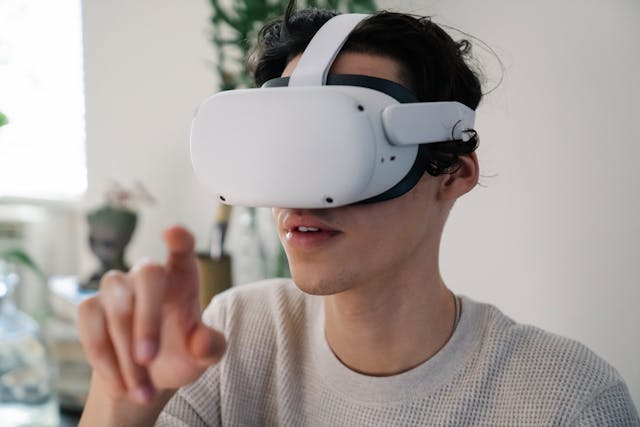Augmented and Virtual Reality in the Workplace: The Future of Training
Augmented and Virtual Reality in the workplace means it is no longer confined to the realm of science fiction or gaming. These immersive technologies are rapidly transforming how we work, learn, and develop skills across every sector of work and industry. Their potential for revolutionising workplace training is vast, offering unprecedented engagement and realism.
The Rise of Augmented and Virtual Reality in the Workplace
The adoption of Augmented and virtual reality training in the workplace has seen significant growth in recent years, driven by several factors, including advancements in technology which have made AR/VR hardware and software more affordable and accessible; the rise of remote working, which has prompted greater attempts and focus on innovative solutions for the remote training needs of businesses; and new studies outlining improved learning and retention through gamification.
Benefits of AR & VR Training
Firstly, the cost of AR/VR equipment has drastically reduced following the rise in VR/AR technology used in gaming and the demand for remote training solutions. As such, the technology is accessible to businesses of all sizes.

There is a wide array of benefits that AR/VR training provide to businesses. Firstly, AR/VR provides a safe and controlled environment for learners to practice real-world skills. Whether it’s a surgeon simulating a complex procedure or a technician learning to repair machinery, trainees can make mistakes and learn from them without any real-world consequences. This fosters a greater sense of confidence and competence before applying skills in a real setting.
AR/VR training is also inherently engaging. Unlike passive learning methods like lectures or textbooks, immersive simulations through gamification captures the learner’s attention and actively involve them in the learning process. This heightened engagement leads to improved knowledge retention and a deeper understanding of the material.
Further to personal safety and improved engagement, AR/VR training is highly scalable and cost-effective. Once developed, training modules can be easily distributed and used repeatedly, eliminating the need for physical training materials and travel expenses. This makes it particularly advantageous for organisations with geographically dispersed teams and has filled a gap in skill development/upskilling that has developed following the rise in remote working positions.
The personalised learning experiences of AR/VR training programs can be tailored to individual needs and learning styles, providing targeted instruction and feedback. This individualised approach maximises learning outcomes and ensures that each trainee progresses at their own pace.
Lastly, AR/VR training offers valuable data and insights. By tracking learner interactions and performance, organisations can identify areas for improvement in the training content and tailor future modules for optimal effectiveness. This data-driven approach to training ensures continuous improvement and refinement of the learning experience.
Limitations & Drawbacks of AR/VR Training
While the potential of AR/VR training is undeniable, it’s important to acknowledge the potential drawbacks that can hinder its widespread adoption and effectiveness.
AR/VR technology necessitates a certain level of technical expertise for implementation and maintenance. This often requires specialised skills that may not be readily available within an organisation, leading to additional costs for training existing staff or hiring new employees.
While immersive experiences are a key strength of AR/VR, poorly designed content can lead to motion sickness, disorientation, or eye strain. AR/VR headsets can also be bulky and uncomfortable to wear for extended periods, potentially hindering user engagement. There are also limitations due to disabilities, personal preference, etc., which mean not everyone can use AR/VR.
Furthermore, creating engaging and effective AR/VR training modules is a complex process that requires collaboration between subject matter experts, instructional designers, and developers. Coordinating these efforts and ensuring the content aligns with learning objectives can be time-consuming and resource intensive.
Additionally, AR/VR training may not fully replicate the tactile experience of real-world interactions. While simulations can be highly realistic, they may fall short when it comes to hands-on skills development or interpersonal communication training.
Finally, there’s a risk of overreliance on technology. While AR/VR is a powerful tool, it shouldn’t be seen as a replacement for all forms of training. A blended approach that combines immersive experiences with traditional methods like mentorship and hands-on practice can often yield the most comprehensive learning outcomes.
Leveraging AR/VR in Tender Responses
When responding to tenders, highlighting your organisation’s use or proposed use of AR/VR training can be a strong differentiator, promoting your organisation as one that is innovative and open to adopting new ideas and approaches. Your Tender Team will ensure this is emphasised to commissioners, position your company as forward-thinking and committed to adopting cutting-edge technologies. It also shows a strong commitment to quality, both of your employees and your services, with a focus on improved learning outcomes, engagement, and efficiency.
Commissioners are always interested in ways to improve service quality whilst managed cost savings effectively. Your Tender Team will use your adoption of AR/VR technologies to highlight your business’ desire to provide the best quality service at the lowest possible cost, highlight the potential long-term cost reductions associated with AR/VR training.
To be able to do these things, Your Tender Team will require specific examples detailing how you’ve used or plan to use AR/VR for specific training scenarios relevant to the tender. We actively encourage you to promote your aim to innovate and adopt AR/VR learning and develop comprehensive case studies that can be explored in tender responses. Where possible, these should be supported by data that shows the success of your AR/VR training programs to demonstrate the effectiveness of your approach. More info on AR training can be found here.
Professional Tender Writing When You Need It
We are on hand to support you with tenders and can rejuvenate your approach to bid writing with our FULL TENDER WRITE service. Get in touch using the form below and one of our team will be in contact to discuss how we can help to grow your business through tendering: